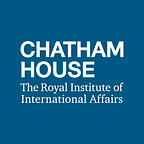The Transatlantic Relationship: Five Things You Should Know
In a time of uncertainty and flux, a new Chatham House report, ‘Transatlantic Relations Converging or Diverging?’, explores the fundamentals of the transatlantic relationship and takes a look at the state of the partnership today and what can be done to support it in the future. Here are five key points you need to know.
(1) In the short-term, there is a rocky road ahead.
The challenges to the transatlantic relationship lie on both sides of the Atlantic. President Trump’s style — unpredictable, changing, thin-skinned and with a short-term perspective — as well as his stated policy choices make the US a difficult partner. Trump’s failure to re-certify the JCPOA, his cancellation of TPP, his withdrawal from the Paris climate change agreement, his recognition of Jerusalem as Israel’s capital, and his vocal scepticism of the value of NATO are all policies inimical to Europe’s interests.
At the same time, US policymakers are also struggling to maintain engagement with European countries, frequently distracted by their own populist and nationalist movements and who have been focused on holding the EU together not least because of Britain’s intended exit, and they are largely unwilling to invest in additional resources to support the ‘global commons’.
(2) However, the fundamentals of the relationship remain strong.
While it is tempting to view the current political climate as evidence of an irreversible deterioration in the transatlantic relationship, in reality, the underlying factors that drive US and European policymaking, and thus their relationship, remain relatively stable. Chatham House researchers identified 12 principal factors behind foreign policy decision-making. Of these, nine are either cyclical and thus short-term or, while others are structural and thus long-term and are moving in similar, and therefore aligned, directions in both Europe and the US. As a result, they do not raise meaningful long-term concerns. Only three structural trends are set to result in meaningful policy divergence: demographics, access to some natural resources in particular food and energy and a change in the role of international institutions.
(3) A number of cyclical factors — namely President Trump himself and broader political polarization — are generating enormous ‘white noise’. While they should not be ignored, their fluctuating nature makes them unlikely to lead to a longer term disruption in the relationship.
Analysis of leadership personalities, economic trends, political polarization and current military capabilities dominates news cycles on both sides of the Atlantic, often creating a great deal of political ‘white noise’. However, they are for the most part cyclical, changing with elections in the case of personalities, or with the ups and downs of the economy. While these factors may well cause challenges in the relationship in the shorter term, and will need to be managed, they are transient and should be of less concern.
(4) It is however, those factors that are diverging structurally between the US and Europe — demographics, natural resources as well as the role of international institutions — on which greatest attention should be paid if the long-term health of the relationship is to be maintained.
Demographic divides as Europe takes in people from the Middle East and Africa, while the US leans towards Latin America, will increasingly drive divergent interests. So too will America’s rising energy self-sufficiency while Europe remains vulnerable to energy providers from the likes of Russia and countries across the Middle East. And the decline of international organizations — and norms — will make holding the US and Europe together harder. These three structural trends are set to complicate the transatlantic relationship and need to be addressed through policies such as promoting the free movement of citizens across the Atlantic, providing greater energy resources to Europe from the US and revitalizing and empowering international organizations as appropriate.
(5) In the short-term, while policy perspectives differ in the US and Europe, such as on trade and the environment, there is an important role for non-state actors, such as businesses, cities, states and NGOs.
While European and American leaders hold differing policy positions, there is an increasingly important role for other actors to pick up the ball. Traditional bureaucratic channels will remain essential for many aspects of diplomacy and international cooperation. But these can also be augmented, for some aspects of transatlantic coordination, by other actors, be they cities, regional state leaders or non-state actors as is currently taking place in order to uphold the US’s responsibilities in line with the Paris climate change agreement. In the absence of senior leadership, they can maintain the status quo or even perhaps make progress on tough issues or lay important groundwork for the future.
